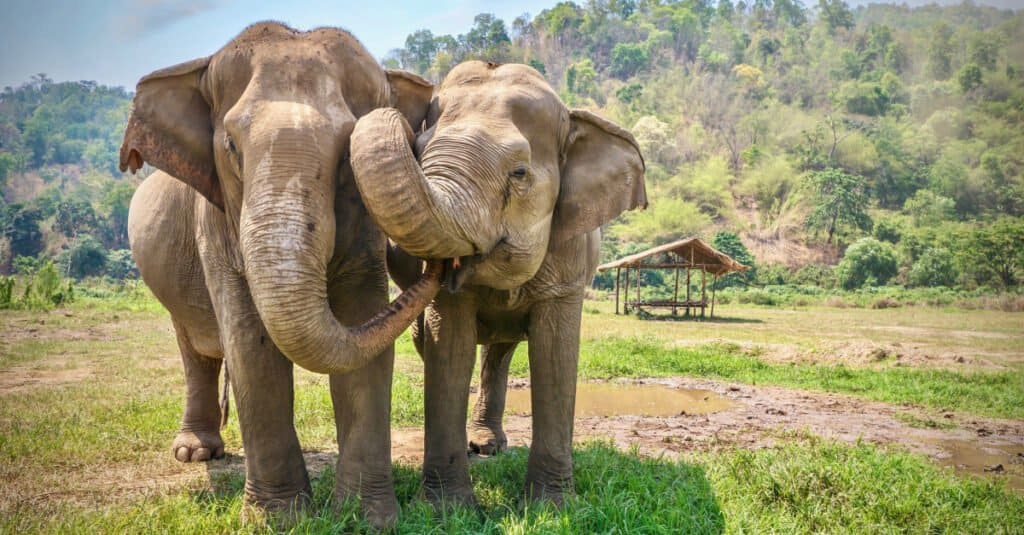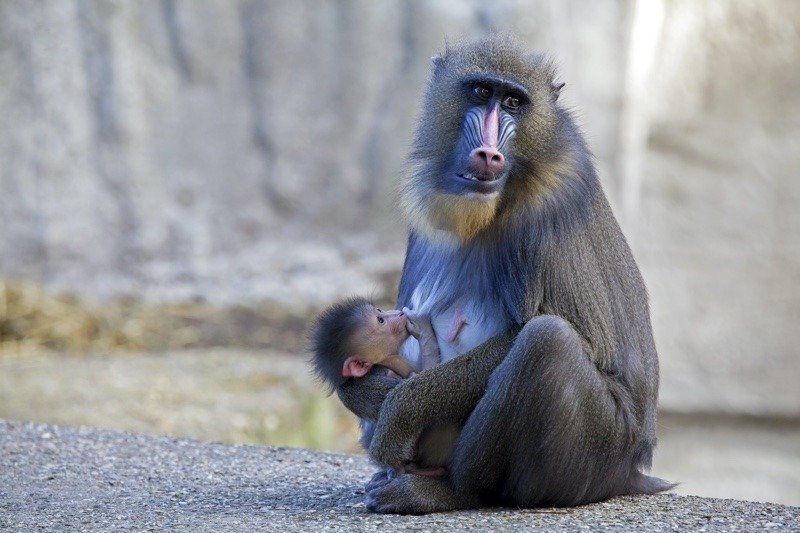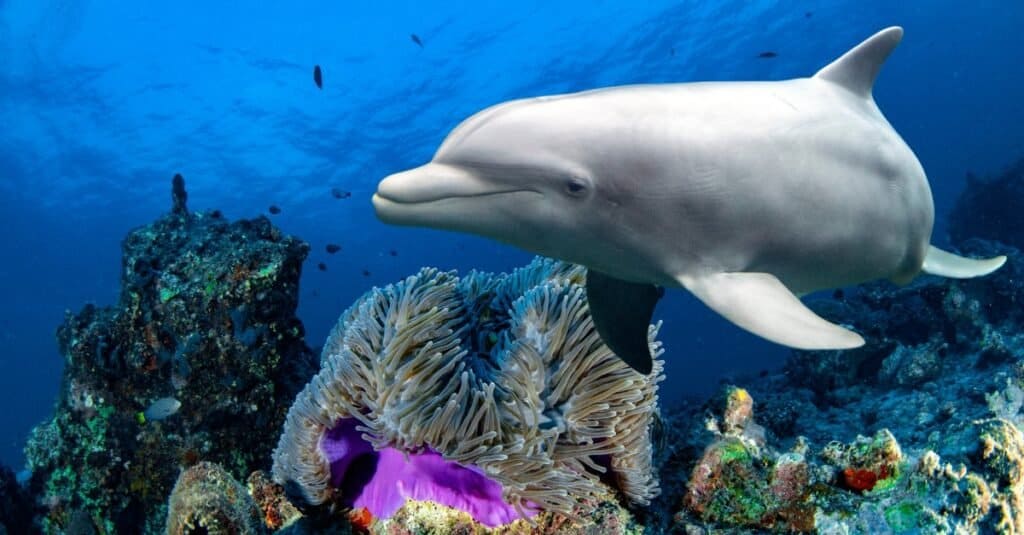When people first think of mammals, they often think of elephants, monkeys, bears, and other land-dwelling animals. There are, however, many species of marine mammals as well. The class Mammalia accounts for an estimated 6,495 species! These diverse species inhabit every terrestrial biome and every ocean around the world.
Mammals come in a great variety of shapes and sizes, and many have incredibly unique adaptations. Although it is hard to believe that a naked mole rat and a gorilla are related, as mammals they share key characteristics that set them apart from other groups of animals such as reptiles or birds. This article will explore how mammals are different from other life on Earth, what mammals exist in our oceans, and most of all, where whales fit in to this tangled web. So, are whales mammals? Let’s find out!
What is a mammal?

Elephants are the world’s largest land mammal
©CherylRamalho/Shutterstock.com
The kingdom Animalia includes all animal life. Within the animal kingdom, the phylum Chordata includes all animals that at some stage of life have a notochord. Within the subphylum Vertebrata (those with backbones) is the class Mammalia– the class of mammals.
Mammals include three groups known as monotremes, marsupials, and eutherians (also called placental mammals). These groupings are based off several traits, primarily the animal’s reproductive system. Monotremes are egg laying mammals including platypuses, echidnas, and their fossil ancestors. Marsupials are mammals that give birth to live young within a pouch. Common examples of marsupials are kangaroos, opossums, and Tasmanian devils. Eutherians, or placentals, give birth at a relatively late stage of development and nourish their young during pregnancy with a placenta. Eutherians have distinctive anatomical characteristics that allow for the longer development and birth of a larger infant. “Placentals” is somewhat of a misnomer, however, because marsupials also have a placenta.
What distinguishes mammals from other animal groups?

A baby
mandrill
nursing
©Edwin Butter/Shutterstock.com
Mammals are distinct from birds, reptiles, amphibians, fish, and invertebrates in three key ways.
First, all mammals have fur or hair. In some species this presents as a very conspicuous, thick coat, whereas in others it may be less obvious. Dolphins, for example, are marine mammals and they are no exception to this rule. Although dolphins do not have a coat of fur like many other mammals, they do have hair follicles around their snout. In the womb, dolphins do have whiskers but most lose them soon after birth. The Amazon River dolphin retains these whiskers and uses them for sensory purposes when searching for prey. All mammals have hair or fur in some capacity.
A second distinguishing trait of mammals is the presence of three middle ear bones collectively called the ossicles. The ossicles are the malleus, incus, and stapes bones. They are located in the middle ear behind the eardrum, also known as the tympanic membrane. These bones are the smallest bones in the human body! They play an important role in transferring energy from the vibrations of the eardrum to the inner ear. Without these bones, mammals would be unable to hear.
A third, very important, mammalian trait is the presence of mammary glands. In fact, mammals are named for the Latin word “mamma” which means breast. The mammary glands of a mother produce milk for her offspring. Mammary glands are present in male and female mammals, but there is increased development in females following estrogen influx at puberty. All mammals, including those where it is not immediately apparent, have mammary glands.
There are many other shared traits amongst mammals however the presence of hair or fur, the middle ear bones, and mammary glands are key.
What are marine mammals?

A
bottlenose dolphin
©Andrea Izzotti/Shutterstock.com
So, we know where mammals fit in the animal kingdom and what distinguishes them from other animal groups, but what are marine mammals? As the name suggests, marine mammals are those that spend much of their time in water. Marine mammals have their own list of unique adaptations to cope with cold temperatures, high pressure depths, swimming efficiently, and breathing whilst living in the water.
Some marine mammals include dolphins, otters, seals, walruses, and even polar bears! Although polar bears do not live in the water in the same way dolphins do, they are considered marine mammals because of the amount of the time they spend in the water and their reliance on it for feeding and survival. Many marine mammals have fins or flippers rather than arms and legs like other mammals. Interestingly though, the anatomy of the fins is quite similar to a land mammal’s arm or leg. For example, a dolphin’s pectoral fins have a humerus, radius, and ulna just like land mammals’ arms. Marine mammals also have the same key three mammalian features: hair or fur, middle ear bones, and mammary glands.
Are whales mammals?

A
Humpback whale
breaching in “Marino Ballena National Park”, Costa Rica
©Claude Huot/Shutterstock.com
Whales are mammals! In fact, the blue whale is the largest mammal and the largest animal to have ever lived! A blue whale typically weighs 220 U.S tons, or 440,000 pounds. This is more than 30 elephants in weight! Sperm whales also have the largest brain of any current or extinct animal species. Whales belong to the infraorder Cetacea within the class Mammalia. Cetaceans include 89 species of closely related whales, dolphins, and porpoises. There are species of whales inhabiting all of the world’s oceans and even species of whales that inhabit deep-sea ecosystems.
All whales have typical mammalian characteristics. Whales are eutherian, or placental, mammals that give birth to live offspring. They have mammary glands, lactate, and nurse their young. Whales all have hair follicles, although most do not grow and retain hair. They also have the three middle ear bones typical of mammals. In addition, all mammals breathe air and do not have gills. Whales breathe air as well, however, they are able to stay under water for long periods before needing to resurface. The sperm whale can stay under water for up to 2 hours!
Whale species are incredibly diverse and have many different behaviors and adaptations. Many whales, despite their incredible size, feed on krill and small fish. Orcas, however, feed on fish, sharks, and other whales. They have even been documented killing great white sharks! Killer whales are amongst the world’s most sophisticated hunters and are able to team up against animals much larger than themselves such as blue whales. Sperm whales are also incredible hunters and are the largest toothed predator in the world. They are the word’s deepest diving mammal and are the chief predators of the giant squid and colossal squid.
Do Whales Give Birth to Live Young?

Echidnas fall into the extremely rare category of monotremes – they are quite different from any other mammal as they lay eggs and have no teats.
©Wayne Butterworth/Shutterstock.com
Yes, whales give birth to live young. While not every single mammal does, almost all mammals give birth to live young, so that is one characteristic common to mammals. Female whales carry their offspring in their wombs until maturity, then give birth to the calves in the water. The calf is typically 1/4 the size of the mother whale. Once born, the mother guides her baby to the surface to take its first breaths of air.
Mammals that lay eggs instead of giving live births are called monotremes. They include:
- Western Long-Beaked Echidna
- Eastern Long-Beaked Echidna
- Short-Beaked Echidna
- Sir David’s Long-Beaked Echidna
- Duck-Billed Platypus
How are different whale species doing today?

Orca whales are considered apex predators
©slowmotiongli/Shutterstock.com
Whales have varying conservation statuses depending on species. Of cetacean species, 7 are vulnerable, 11 are endangered, and 5 are critically endangered. Species of whales that are endangered include the killer whale, Mediterranean sperm whale, and blue whale. Killer whales are apex predators, meaning no other animals prey on them. As such, they are a keystone species and have a very important ecological role that will leave their ecosystem vulnerable to collapse should they become extinct.
The primary threats to whale species are whaling, bycatch, and habitat destruction caused by pollution and global warming. Commercial whaling- large-scale hunting of whales for profit- was a large industry through the 17th, 18th, and 19th centuries. This industry peaked with its most profitable year in 1853. American profits reached $11,000,000, which is equivalent to $348,000,000 today scaling for inflation. Despite the establishment of the International Whaling Commission (IWC), member countries Norway, Iceland, and Japan still have sizable whaling industries. Whales are also unintentionally caught as bycatch when commercial fisheries are attempting to fish for other species.
Since the establishment of the IWC, some whale species have begun to repopulate. The IWC has two recognized whale sanctuaries including 11.8 million square miles in the Southern Ocean and all of the Indian Ocean south of 55ºS latitude. The IWC, however, is a voluntary organization that a country can leave with no obligation to stay. The commission is also incapable of enforcing any laws it passes.
Whales in captivity

A beluga whale in captivity
©kuremo/Shutterstock.com
Whales kept in captivity for human amusement has been a controversial topic for years. Despite how cool it may seem to see such a majestic creature up close, whales do not belong in tanks. 176 orca whales have died in captivity, not including an additional 30 miscarried or stillborn calves. 40 whales have died in captivity at SeaWorld alone and they have 19 in captivity today. Worldwide, there are currently 58 orca whales in captivity.
Conditions in aquatic theme parks and aquariums are not suitable for these beautiful animals. In Miami Seaquarium, a killer whale named Lolita is kept in a tank that is less than two times her body length at any given point. In such a confined space, she can barely move. The vast majority of captive killer whales have a collapsed dorsal fin, meaning it is no longer erect and droops to one side. The Whale and Dolphin Conservation says this is largely due to swimming in small circles because of inadequate space. Collapsed fins are incredibly rare in the wild.
Several studies have suggested that a killer whale’s lifespan is three times shorter in captivity than in the wild. They are more susceptible to disease in captivity and, due to the shallowness of their tanks, they are more susceptible to sunburns and the development of cataracts from UV exposure. Prolonged UV exposure can cause skin damage to orcas including melanoma. A 14-year-old male killer whale named Taku was kept in SeaWorld San Antonio until his unexpected death. It was determined he died of pneumonia, which is common amongst captive orcas, and that he was infected with West Nile Virus.
While seeing whales at aquariums may be fun, don’t be so sure the whales feel the same.
The photo featured at the top of this post is © Imagine Earth Photography/Shutterstock.com
Thank you for reading! Have some feedback for us? Contact the AZ Animals editorial team.







